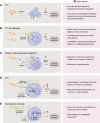Biological and clinical implications of a model of surveillance immunity
- PMID: 40759580
- PMCID: PMC12321384
- DOI: 10.1172/JCI191645
Biological and clinical implications of a model of surveillance immunity
Abstract
The immune system must identify genuine threats and avoid reacting to harmless microbes because immune responses, while critical for organismal survival, can cause severe damage and use substantial energy resources. Models for immune response initiation have mostly focused on the direct sensing of microorganisms through pattern recognition receptors. Here, we summarize key features of the leading models of immune response initiation and identify issues they fail to solve individually, including how the immune system distinguishes between pathogens and commensals. We hypothesize and argue that surveillance of disruption to organismal homeostasis and core cellular activities is central to detecting and resolving relevant threats effectively, including infection. We propose that hosts use pattern recognition receptors to identify microorganisms and use sensing of homeostasis disruption to assess the level of threat they pose. We predict that both types of information can be integrated through molecular coincidence detectors (such as inflammasomes or others not yet discovered) and used to determine whether to initiate an immune response, its quality, and its magnitude. This conceptual framework may guide the identification of novel targets and therapeutic strategies to improve the progression and outcome of infection, cancer, autoimmunity, and chronic conditions in which inflammation plays a critical role.
Conflict of interest statement
Figures



Similar articles
-
Short-Term Memory Impairment.2024 Jun 8. In: StatPearls [Internet]. Treasure Island (FL): StatPearls Publishing; 2025 Jan–. 2024 Jun 8. In: StatPearls [Internet]. Treasure Island (FL): StatPearls Publishing; 2025 Jan–. PMID: 31424720 Free Books & Documents.
-
Signs and symptoms to determine if a patient presenting in primary care or hospital outpatient settings has COVID-19.Cochrane Database Syst Rev. 2022 May 20;5(5):CD013665. doi: 10.1002/14651858.CD013665.pub3. Cochrane Database Syst Rev. 2022. PMID: 35593186 Free PMC article.
-
Management of urinary stones by experts in stone disease (ESD 2025).Arch Ital Urol Androl. 2025 Jun 30;97(2):14085. doi: 10.4081/aiua.2025.14085. Epub 2025 Jun 30. Arch Ital Urol Androl. 2025. PMID: 40583613 Review.
-
Interventions to improve safe and effective medicines use by consumers: an overview of systematic reviews.Cochrane Database Syst Rev. 2014 Apr 29;2014(4):CD007768. doi: 10.1002/14651858.CD007768.pub3. Cochrane Database Syst Rev. 2014. PMID: 24777444 Free PMC article.
-
How lived experiences of illness trajectories, burdens of treatment, and social inequalities shape service user and caregiver participation in health and social care: a theory-informed qualitative evidence synthesis.Health Soc Care Deliv Res. 2025 Jun;13(24):1-120. doi: 10.3310/HGTQ8159. Health Soc Care Deliv Res. 2025. PMID: 40548558
References
Publication types
MeSH terms
Substances
LinkOut - more resources
Full Text Sources

